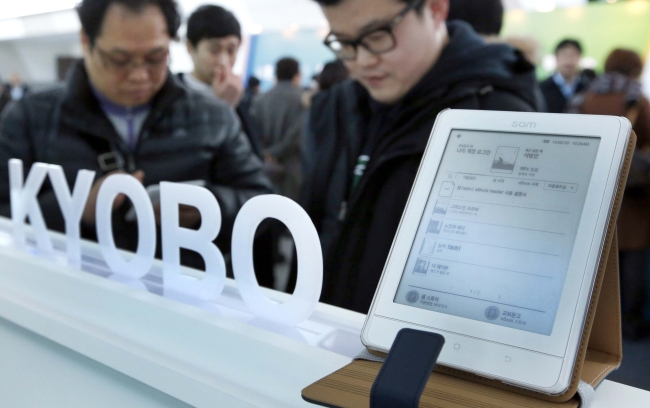34세 회사원 정혜선씨는 최근 전자책을 읽기 시작했다. 그녀는 출퇴근 길에 아이패드를 통해 경영학 서적을 읽곤 한다.

“전자책이 편리합니다. 큰 가방에 책을 넣고 다니는 대신, 태블릿 피씨 등을 조그만 손가방에 넣어 가지고 다녀도 됩니다. 중요한 부분에 밑줄을 긋거나 검색 기능을 눌러서 찾고자 하는 부분으로 가볼 수도 있습니다. 책갈피, 사전 그리고 다른 기능들이 그냥 화면을 누르면 튀어나오게 됩니다. 정말 좋은 것 같습니다.”
정씨와 같이 점점 더 많은 사람들이 전자책을 읽기 시작하고 있다.
문화체육관광부가 10세에서 69세 사이의 사람 2000명을 설문조사한 결과, 14.6%는 이미 전자책을 읽고 있는 것으로 나타났다. 이는 책을 읽고 있지 않은 사람을 포함 한국인 모두 일년에 1.6권의 전자책을 읽는 것으로 환산된다고 정부는 밝혔다. 젊고 교육을 많이 받을수록 전자책을 읽을 확률이 큰 것으로 나타났다.
38.3%는 문학작품들을 읽었고, 취미나 전기, 자기계발서, 요리나 종교서적이 그 뒤를 이었다. 25.3 %는 재미를 위해 책을 읽는 반면 다른 이들은 자기 계발과 실용적인 목적을 위해 책을 읽는다고 밝혔다.
“우리는 지난 2-3년 사이에 시장이 크고 있는 것을 목격했습니다,” 이북스펍을 운영하고 있는 크리스 최씨가 말했다. 그는 2010년에 이 업계에 들어와 지난8월 자신의 전자책을 처음으로 출간했다. 그는 8개월이 채 지나지 않아 매출이 30배 정도 증가했다고 말했다.
최씨는 스마트폰이나 아이패드의 보급이 전자책 유행을 선도했다고 말한다. 실제로 정부의 보고서에 따르면 44.4% 의 전자책 이용자들은 스마트폰으로 전자책을 구독한다고 했다. PC, 태블릿 PC, 그리고 전자책 단말기 등이 그 뒤를 잇는다.
시장의 성장의 또다른 견인책은 컨텐츠의 성장이다. “오프라인 책들 중 상당수가 온라인으로도 발간됩니다,” 웅진출판의 정동윤씨가 말했다. 웅진은 약 900여종의 전자책을 발간해서 예스24, 리디북이나 교보를 통해 팔고 있다.
“전자책은 굉장히 좋은 사업기회입니다. 종이가 들지 않기 때문에 코스트는 줄지만 회사나 작가에게는 동일한 또는 더 많은 이익을 보장하기 때문입니다. 그리고 사용자들의 편리함까지 감안할 때 전망은 매우 좋습니다,” 최씨가 말했다.
이미 업계는 발빠르게 움직이고 있다. 국내 최대 서점인 교보문고는 전자책 단말기 샘을 출시하며 정액제 대여제도를 도입했다. 57개의 전자책 출판사들이 모여서 지난달 한국전자출판협동조합을 발족했다. 이 조합은 앞으로 컨텐츠 개발에서부터 해외진출까지 모든 부분에 협력을 다짐했다.
“우리는 사람들의 주의를 끄는데 신경을 쓸 예정입니다,” 최씨가 말했다.
하지만 아직도 회의적인 시선은 있다. 유통채널이 제한적이다 – 애플이 운영하는 아이튠즈나 세계최대의 서점은 아마존에 한국어 전자책은 거의 없다. “온라인 몇몇 서점은 제외하면 사람들이 온라인 컨텐츠를 둘러볼 수 있는 기회가 거의 없습니다,” 전자책 사용자 중 하나인 김하연씨가 말했다.
그리고 시장의 잠재력이 얼마나 큰지도 의문이다. 정부의 보고서에 따르면 50.6%의 응답자들이 종이책 위주로 독서를 할 것이라고 말했고, 아직 전자책을 읽어보지 못한 사람들이 49.6%는 전자책을 읽을 생각이 없다고 밝혀서 읽어보겠다고 말한 19.8%의 두배를 상회했다.
“책장을 넘기는 행위가 좋습니다. 매우 특별한 경험입니다. 전자책도 좋지만, 아마 종이책이 좀 더 특별하게 다가오는 것 같습니다,”정씨가 말했다.
“디지털 컨텐츠를 좀 더 화보하고, 단말기의 보급을 늘리고 사람들로 하여금 한번 사용해볼 수 있는 기회를 주는 것이 전자책 문화를 보급시키는데 중요하다”고 정부는 말했다. (코리아헤럴드 배지숙 기사 baejisook@heraldcorp.com)
정씨와 같이 점점 더 많은 사람들이 전자책을 읽기 시작하고 있다.
문화체육관광부가 10세에서 69세 사이의 사람 2000명을 설문조사한 결과, 14.6%는 이미 전자책을 읽고 있는 것으로 나타났다. 이는 책을 읽고 있지 않은 사람을 포함 한국인 모두 일년에 1.6권의 전자책을 읽는 것으로 환산된다고 정부는 밝혔다. 젊고 교육을 많이 받을수록 전자책을 읽을 확률이 큰 것으로 나타났다.
38.3%는 문학작품들을 읽었고, 취미나 전기, 자기계발서, 요리나 종교서적이 그 뒤를 이었다. 25.3 %는 재미를 위해 책을 읽는 반면 다른 이들은 자기 계발과 실용적인 목적을 위해 책을 읽는다고 밝혔다.
“우리는 지난 2-3년 사이에 시장이 크고 있는 것을 목격했습니다,” 이북스펍을 운영하고 있는 크리스 최씨가 말했다. 그는 2010년에 이 업계에 들어와 지난8월 자신의 전자책을 처음으로 출간했다. 그는 8개월이 채 지나지 않아 매출이 30배 정도 증가했다고 말했다.
최씨는 스마트폰이나 아이패드의 보급이 전자책 유행을 선도했다고 말한다. 실제로 정부의 보고서에 따르면 44.4% 의 전자책 이용자들은 스마트폰으로 전자책을 구독한다고 했다. PC, 태블릿 PC, 그리고 전자책 단말기 등이 그 뒤를 잇는다.
시장의 성장의 또다른 견인책은 컨텐츠의 성장이다. “오프라인 책들 중 상당수가 온라인으로도 발간됩니다,” 웅진출판의 정동윤씨가 말했다. 웅진은 약 900여종의 전자책을 발간해서 예스24, 리디북이나 교보를 통해 팔고 있다.
“전자책은 굉장히 좋은 사업기회입니다. 종이가 들지 않기 때문에 코스트는 줄지만 회사나 작가에게는 동일한 또는 더 많은 이익을 보장하기 때문입니다. 그리고 사용자들의 편리함까지 감안할 때 전망은 매우 좋습니다,” 최씨가 말했다.
이미 업계는 발빠르게 움직이고 있다. 국내 최대 서점인 교보문고는 전자책 단말기 샘을 출시하며 정액제 대여제도를 도입했다. 57개의 전자책 출판사들이 모여서 지난달 한국전자출판협동조합을 발족했다. 이 조합은 앞으로 컨텐츠 개발에서부터 해외진출까지 모든 부분에 협력을 다짐했다.
“우리는 사람들의 주의를 끄는데 신경을 쓸 예정입니다,” 최씨가 말했다.
하지만 아직도 회의적인 시선은 있다. 유통채널이 제한적이다 – 애플이 운영하는 아이튠즈나 세계최대의 서점은 아마존에 한국어 전자책은 거의 없다. “온라인 몇몇 서점은 제외하면 사람들이 온라인 컨텐츠를 둘러볼 수 있는 기회가 거의 없습니다,” 전자책 사용자 중 하나인 김하연씨가 말했다.
그리고 시장의 잠재력이 얼마나 큰지도 의문이다. 정부의 보고서에 따르면 50.6%의 응답자들이 종이책 위주로 독서를 할 것이라고 말했고, 아직 전자책을 읽어보지 못한 사람들이 49.6%는 전자책을 읽을 생각이 없다고 밝혀서 읽어보겠다고 말한 19.8%의 두배를 상회했다.
“책장을 넘기는 행위가 좋습니다. 매우 특별한 경험입니다. 전자책도 좋지만, 아마 종이책이 좀 더 특별하게 다가오는 것 같습니다,”정씨가 말했다.
“디지털 컨텐츠를 좀 더 화보하고, 단말기의 보급을 늘리고 사람들로 하여금 한번 사용해볼 수 있는 기회를 주는 것이 전자책 문화를 보급시키는데 중요하다”고 정부는 말했다. (코리아헤럴드 배지숙 기사 baejisook@heraldcorp.com)
<관련 영문 기사>
Will digital be the final page for books?
By Bae Ji-sook
Thirty-four-year-old office worker Chung Hye-sun has started reading e-books, readable on computers and other electronic devices.
She enjoys reading business management books on her iPad while commuting and whenever possible.
“E-books are convenient. Instead of having to carry books in a large bag, all you need is a light and thin tablet PC or other gadgets in my purse,” she said. “You can underline important passages, press the ‘search’ tab to find the exact sentences or parts you need. Bookmark, dictionary and other functions are also available by pressing the screen. I just love it,” she said.
Many Koreans like Chung have started replacing paper books with digital publications.
According to a Ministry of Culture, Sports and Tourism survey of 2,000 people aged 10-69, 14.6 percent are already reading e-books, which translates to the average Korean reading 1.6 digital books a year. Younger and more educated people are more likely to be an e-book user, the report showed.
About 38.3 percent enjoyed literature, followed by sports and leisure, biography, self-help, cooking and religious content. About 25.3 percent said they read for fun while intellectual desire, self-development and practical aims followed.
“We have seen the e-book market increase in the past couple of years,” said Chris Choi, who runs e-book publishing company, ebooks Pub. Choi, who started his business in 2010 and released his first e-book last August, said he had seen sales soar 30 times in less than eight months.
Choi said the widespread use of smartphones, iPads and other digital gadgets had contributed to the growth. The ministry research also noted that 44.1 percent of e-book users read publications with smartphones followed by personal computers, tablet PCs and e-book readers.
Another factor driving the market expansion is the growing amount of digital content available.
“These days, many of the books published offline are released online, too,” said Jung Dong-youn at Woongjin Think Big, a major publisher. His company has more than 900 e-books at online outlets including yes24, Ridi books, Kyobo and others.
“E-book publication is a great opportunity because the paperless business costs less but guarantees equal amount of income to both the company and the author. Combined with users’ convenience, I think there is a great future,” Choi said.
The business is moving quickly, too. Kyobo Book Center, the country’s largest bookstore, recently released Sam, its own e-book reader, and launched a leasing program, loaning out e-books on a fixed-payment basis.
A total of 57 e-book publishers established Korea eBook Publishing Coop last month to cooperate on various issues from content development to overseas expansion including translation and joint marketing.
“We will be aggressive about raising public awareness,“ Choi said.
But skepticism remains. The distribution channels are limited -- the majority of e-book publishers have yet to make it onto iBook or iTunes, a market for Apple gadget users, and the world’s largest online bookstore Amazon.com has yet to offer Korean-language products.
“Except for a few online stores, there aren’t many ways for people to access online content,” said Kim Ha-yeon, another e-book user.
Whether the market has great potential also remains uncertain. The ministry report noted that 50.6 percent of the surveyed people said they would continue to read mainly paper books in the future, with 49.6 percent of non-e-book users saying they had no plans to try digital books in the future, double the number of 19.8 percent who were positive about trying digital titles.
“I love the feeling of turning the pages, which is a special experience. E-books are nice but paper books will always be closer to my heart,” Chung said.
“We will need more digital content, wider provision of e-book readers or other gadgets and to allow people try reading e-books in order to cultivate the relevant culture,” the ministry report concluded. (baejisook@heraldcorp.com)
Will digital be the final page for books?
By Bae Ji-sook
Thirty-four-year-old office worker Chung Hye-sun has started reading e-books, readable on computers and other electronic devices.
She enjoys reading business management books on her iPad while commuting and whenever possible.
“E-books are convenient. Instead of having to carry books in a large bag, all you need is a light and thin tablet PC or other gadgets in my purse,” she said. “You can underline important passages, press the ‘search’ tab to find the exact sentences or parts you need. Bookmark, dictionary and other functions are also available by pressing the screen. I just love it,” she said.
Many Koreans like Chung have started replacing paper books with digital publications.
According to a Ministry of Culture, Sports and Tourism survey of 2,000 people aged 10-69, 14.6 percent are already reading e-books, which translates to the average Korean reading 1.6 digital books a year. Younger and more educated people are more likely to be an e-book user, the report showed.
About 38.3 percent enjoyed literature, followed by sports and leisure, biography, self-help, cooking and religious content. About 25.3 percent said they read for fun while intellectual desire, self-development and practical aims followed.
“We have seen the e-book market increase in the past couple of years,” said Chris Choi, who runs e-book publishing company, ebooks Pub. Choi, who started his business in 2010 and released his first e-book last August, said he had seen sales soar 30 times in less than eight months.
Choi said the widespread use of smartphones, iPads and other digital gadgets had contributed to the growth. The ministry research also noted that 44.1 percent of e-book users read publications with smartphones followed by personal computers, tablet PCs and e-book readers.
Another factor driving the market expansion is the growing amount of digital content available.
“These days, many of the books published offline are released online, too,” said Jung Dong-youn at Woongjin Think Big, a major publisher. His company has more than 900 e-books at online outlets including yes24, Ridi books, Kyobo and others.
“E-book publication is a great opportunity because the paperless business costs less but guarantees equal amount of income to both the company and the author. Combined with users’ convenience, I think there is a great future,” Choi said.
The business is moving quickly, too. Kyobo Book Center, the country’s largest bookstore, recently released Sam, its own e-book reader, and launched a leasing program, loaning out e-books on a fixed-payment basis.
A total of 57 e-book publishers established Korea eBook Publishing Coop last month to cooperate on various issues from content development to overseas expansion including translation and joint marketing.
“We will be aggressive about raising public awareness,“ Choi said.
But skepticism remains. The distribution channels are limited -- the majority of e-book publishers have yet to make it onto iBook or iTunes, a market for Apple gadget users, and the world’s largest online bookstore Amazon.com has yet to offer Korean-language products.
“Except for a few online stores, there aren’t many ways for people to access online content,” said Kim Ha-yeon, another e-book user.
Whether the market has great potential also remains uncertain. The ministry report noted that 50.6 percent of the surveyed people said they would continue to read mainly paper books in the future, with 49.6 percent of non-e-book users saying they had no plans to try digital books in the future, double the number of 19.8 percent who were positive about trying digital titles.
“I love the feeling of turning the pages, which is a special experience. E-books are nice but paper books will always be closer to my heart,” Chung said.
“We will need more digital content, wider provision of e-book readers or other gadgets and to allow people try reading e-books in order to cultivate the relevant culture,” the ministry report concluded. (baejisook@heraldcorp.com)








![[Weekender] Korean psyche untangled: Musok](http://res.heraldm.com/phpwas/restmb_idxmake.php?idx=644&simg=/content/image/2024/05/02/20240502050841_0.jpg&u=)








![[Eye Interview] 'If you live to 100, you might as well be happy,' says 88-year-old bestselling essayist](http://res.heraldm.com/phpwas/restmb_idxmake.php?idx=652&simg=/content/image/2024/05/03/20240503050674_0.jpg&u=)
